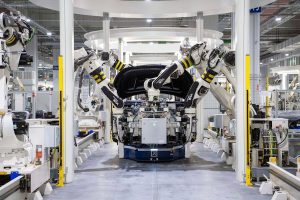Understanding the Different Linear Sensor Technologies Used Today

Linear position technologies used today have varying characteristics such as stroke length, cost, reliability, and environmental resistance. Comparing these differences helps in determining which type of linear sensor best suits the application at hand.
This article will further explain how each type of linear sensor works as well as their defining features and characteristics.
Potentiometer
A potentiometer is a capacitive resistance transducer which consists of three terminals. The output terminal or the slider is fixed to the moving object and detects the displacement which is converted into electrical signals.
Potentiometers are known to be the most economical linear position sensors with the simplest working principle. Unfortunately, since potentiometers require mechanical contact to produce positive signal output, it does not have high repeatability.
Potentiometers also deteriorate due to contact and friction from the moving object. For applications subject to liquid immersion, high vibration, and high temperature, potentiometers are not very suitable.
Linear variable displacement transducer
An LVDT is also sometimes known as a linear transducer or linear position sensor. The mechanism consists of a three-winding coil assembly, a core, and the housing. An LVDT is a non-contact type of linear sensor which produces an electrical signal as the output. These devices are robust and have high repeatability. They are suitable for applications exposed to extreme environmental conditions such as high and low temperatures, fluid immersion, shock, and vibration.
Some of the challenges with LVDTs in the past were the high cost and stroke length. Nevertheless, these challenges were overcome when low-cost microelectronics became widely available.
Encoders
A linear position encoder makes use of magnetic or optical gratings to produce a constant stream of digital signals which are then decoded by a reading head. Encoders are either absolute or incremental. An incremental encoder produces output in pulses which refers to the unit of movement.
On the other hand, an absolute encoder produces binary signals corresponding to a predetermined resolution scale.
Incremental encoders have high precision but have limited frequency responses. This makes them suitable only for applications with slow dynamics. These encoders also require precision electronics which are rather complex and expensive.
Even so, encoders are commonly applied in robotics and laboratory equipment which can accommodate cost and fragility.
Magnetorestrictive sensors
The parts of a magnetorestrictive sensor include a waveguide, pick-up coil, sensing magnet, and electronics. The sensing magnet is connected to the moving target object, while the waveguide is attached to the non-moving part of the object.
To determine the location of the sensing magnet, a current pulse applied to the waveguide produces a sonic wave where the magnet is located. The sonic wave travels and gets picked up, then the timer stops. The elapsed time indicated in the timer represents distance traveled by the target object.
Magnetorestrictive sensors offer accurate readings and are often used for long-stroke applications in cylinders and simulators.
However, these sensors are also quite expensive and are not suitable for working conditions with temperature extremes, high vibration, or severe shock.
Here is a Comparison Table summarizing the key features of different linear position sensing technologies:
| Technology | Principle | Accuracy | Resolution | Operating Environment | Response Time | Cost |
|---|---|---|---|---|---|---|
| Potentiometers | Resistive wiper | Moderate | Moderate | Limited by mechanical wear | Fast | Low |
| LVDTs | Electromagnetic induction | High | High | Harsh environments | Fast | Moderate |
| Magnetostrictive Sensors | Magnetostriction | High | High | Harsh environments | Fast | Moderate |
| Linear Encoders | Optical/Magnetic pattern | Very High | Very High | Clean environments | Very Fast | High |
| Capacitive Sensors | Capacitance change | Moderate to High | Moderate to High | Non-metallic environments | Moderate to Fast | Moderate |
| Inductive Sensors | Electromagnetic induction | Moderate to High | Moderate to High | Harsh environments | Moderate to Fast | Moderate |
Conclusion
Various linear sensor technologies offer diverse advantages and applications, catering to the specific needs of different industries and applications.
Each technology has its strengths and limitations, making them suitable for particular use cases.






